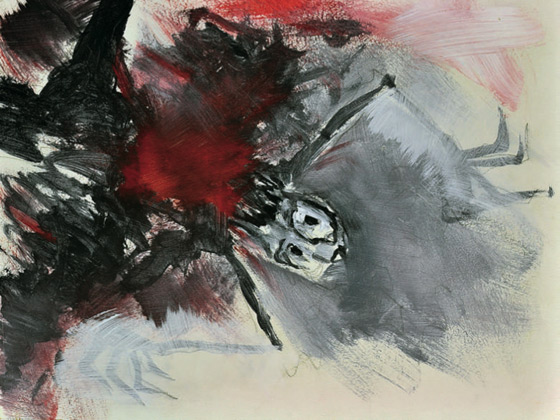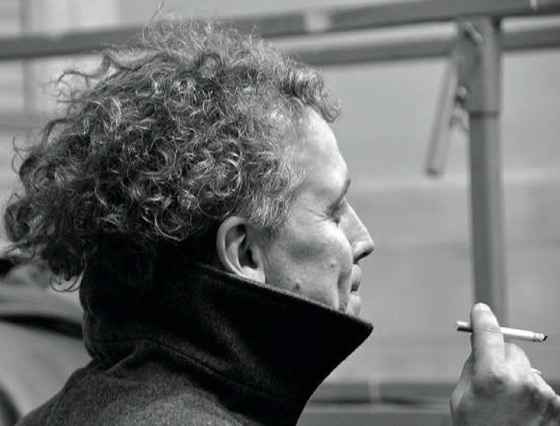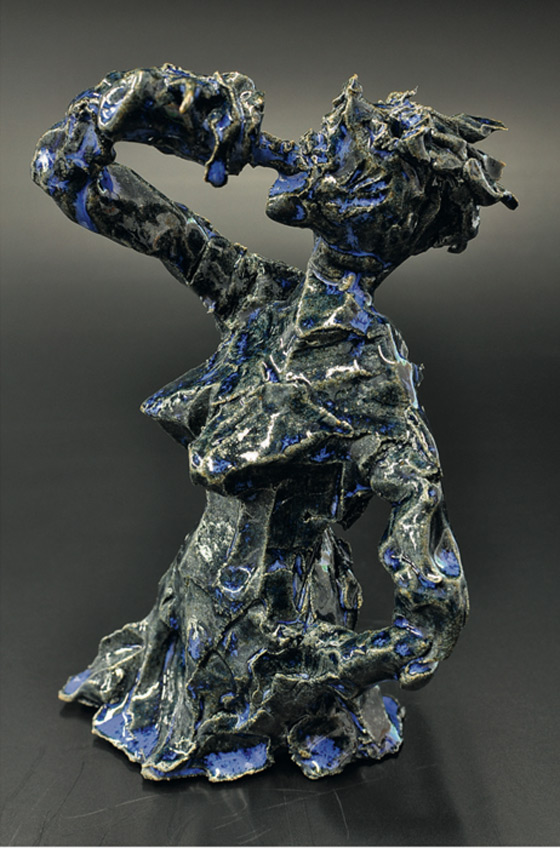|
|
| Finding the good in a bad situation Santa Mičule, Art critic Review of Raids Kalniņš’ exhibition Disaster in the Village or Dinosaurs are Eating from the Graves at the Liepāja City Museum, 04.07–03.08.2014 | |
| “Why is the weather always bleak, while groans can be heard from the depths of the earth? the breeze from the forest brings the odour of abandonment. the earth in the graves is very soft, and the old people are worried about this. it won’t be like the times we’re used to, everything will be semi-living, half-dead.... the past is approaching.... doubts, unpleasant suspicions, rural people are suffering from animal attacks that were previously considered impossible. collapsing houses that can’t be repaired and the continual intrusion of the swamp, making the nearby cemetery uneasy...disaster in the village.” the introductory text for the exhibition, in brief, introduces the world in which artist raids kalniņš resides. he’s been involved in its portrayal for many years now, creating his own personal Chronicles of narnia and stories from the crypt. not in a really serious way, sort of as a joke, but the result has the multi-layeredness of a cinematographic image, created in the best neo-expressionist traditions, although i wouldn’t want to label the artist as a follower of this particular direction – it’s too comical and witty for this. | |
 Raids Kalniņš. Restless Dying man. Acrilyc on cardboard. 2012 Publicity photo Courtesy of the artist | |
| In the exhibition’s press release, kalniņš’ works were declared to be eccentric. the choice of this description raises a smile, as nothing overly strange or unusual can be encountered there, at least judging from the criterion of extremes within contemporary art: drawings and paintings made using various techniques and materials, which, step by step, illustrate strange incidents and phenomena. an extended comic book with monsters, skeletons, half-humans and beasts, which, as has already been written about at other times when mentioning kalniņš, don’t seem to be either frightening or scary, but strangely lovable and friendly instead. the artist has been able to find and develop a style of painting that imparts seemingly human qualities to what is portrayed. the works have a sincerity similar to that which we remember from our childhood books, the illustrations of which were able to conjure up a quite believable parallel world and to a large degree influence the visualisation in our minds of what was being read. at the core of kalniņš’ art language is a powerful expression that dominates in the spontaneous brush stroke, the simplification of form and the nervous, hurried lines. the works seem to have been created in a single breath, or a single brush stroke, and their masterful movement also heightens the expressiveness of the scenes. the artist’s style is intriguing, but a desire to see it outside the “village” arises, in different themes that could, perhaps, allow it to more fully realise its passion for romantic expression. this has been partly attempted in the small sculptures, which repeat the ghoulish images in sculptural forms and supplement what has been painted in the sense of expression. overall, the contribution of the figures cannot be described as successful; the works look like souvenirs or haphazard experiments, which could have been avoided by a more successful arrangement of them at the exposition. This is the visible part of the iceberg. after the glorification of the explosive form, the desire arises to discover the broader interrelationships in kalniņš’ comics. in an attempt to try to get a better understanding of what’s on show at the exhibition, the psycho-biographical approach “kicks in” first, namely, the challenge of finding the artist’s spiritual self-portrait in what’s been painted, the explanation of the iconography of horror as the sublimation of private neuroses, and similar thoughts to which the various pseudo-psychological clichés lead. the self-invented story about the forlorn village artist has been intriguing for quite some time now, and variations on this theme have been developed over many years. kalniņš seems to have been doomed to grapple with the ghoulish theme, in which he himself is the director, the stage designer and also the very dexterous cameraman. as a horror motif, its execution has a slightly boyish escapism, the ideological genealogy of which is rooted in the culture of romanticism and the still widespread tendency to approach the horizons of other worlds with the assistance of art. ernests kļaviņš’ absurdities, miķelis fišers’ esoteric world or the freaks portrayed by harijs brants serve as the closest and most recent kindred examples, not to mention the dominating imagery of “otherness” in the flourishing genre of comics and illustration. the short stories by kalniņš, as opposed to the previously listed authors, are characterised by a mix of pop-culture and mythological narrative, which can be noticed in a slightly folklorised iconography of image and a deliberately naïve expression of narrative. at the same time, the exhibition seemed very introverted and not totally fathomable, even though the titles of the works unambiguously explained what was portrayed and were even hand-written (a very pleasant departure from the sterility of computer print). as i mentioned previously, i don’t wish to amateurishly dig around in the artist’s personality through the iconography of what is depicted, however, kalniņš’ little scenes of horror could possibly be interpreted not just as the fruits of the artist’s peculiar fantasy but also as allegories of the modern feeling for the world that are inescapably connected with broader cultural-sociological processes. | |
 Raids Kalniņš. 2014 Photo from the private archive of Raids Kalniņš | |
| In her book Fear and art in the Contemporary World (2012) culture theorist caterina albano points to similarities between horror films and contemporary art. in her opinion, both cultural phenomena are influenced to a large degree by popular culture that has blended with elements of high art in a hybrid way (though i don’t rush to agree with such a formulation) as well as the way in which they manipulate with the viewer. the viewer’s reaction to a great deal of contemporary artworks and horror films is integrated in the work itself and is an important component of it; the function of the work is closely connected with intellectual or psychological emotions. independently of whether the viewer submits to the programmed reaction, the artwork’s move to psychological influence is significant even if it’s not possible to “measure” the experience of the specific emotion. in other words, both contemporary art and horror films show the potential of an image to create a perturbed state independently of the viewer’s imperturbability. today’s visual culture has to be affective and capable of shocking; it has to have the capacity to influence the consumer, breaking ever new taboos and creating ever new thresholds of perception preparedness. this culture manipulates with a way of experiencing the aesthetic that inevitably includes powerful psychological, affective reactions within it. Without trying to measure emotions and the immense degree to which kalniņš’ buffoons and rascals have frightened us, the horror elements, and the artist’s desire to work with this theme in particular, allow us to think about the works as at least partly belonging to the so-called fear aesthetic and fear culture. these concepts tend to appear in articles about artwork created as a result of the 20th century’s powerful political and social upheavals, attempting to convince us that the seeking of artistic refuge in horror genres is a phenomena that has become deeply rooted in western culture outside the romanticism tradition. frank furedi, a sociologist of hungarian descent – and not just him alone – defined fear as the main influence on the 21st century person’s consciousness and an important component of the social living space. but, unlike previous centuries, when there were real threats forming a basis for fear, the modern person increasingly fabricates his/her own fear. taking a slightly closer look at sociological theories about fear, the conclusions can seem surprising by their contradictory nature: even though the general standard of living has increased substantially and people’s ability to make decisions about the course of their lives and control the forces and conditions of nature has increased to an even greater degree, the feeling of fear and anxiety has increased to the same degree, and the theories of some authors have even allocated these feelings with the status of the Zeitgeist of the time. | |
 Raids Kalniņš. People of Long ago. Rock mass. 2014 Photo: Māris Jašs Publicity photo Courtesy of the artist | |
| Through the invocation of this fear theory i wished to point to the feelings that overtook me when i spent a longer period at the liepāja museum’s exhibition hall. the source of kalniņš’ horror stories can be found not only in the artist’s individual fantasy world but also in that super/semi/sub/conscious of mankind in which all of us, as social creatures, are engaged in what we could call the spirit of the age, a state of mind, a direction. an extended attachment to the forlorn village theme and the dwelling on its grotesque harshness is, on the one hand, the artist’s own personal business, and any attempts to analyse this from some imagined viewpoint of normality is a breaking into unknown private territory. the obsession (if we can call it that) with gothic horror films could be both a side effect of the previously described fear culture as well as a state of being stuck in an adolescent-like simplified world view in which irrational evil and fatal events, independent of the individual him/herself, dominate. to the same degree, this “obsession” could be an attempt to come to terms with the irrational by playing around with it, making it naïve and innocuous. accepting various explanatory versions, kalniņš’ art becomes closer and more understandable to me personally if i look at it as an attempt to take refuge from the misfortunes of reality in the horror scenes he has created (painted) himself – perhaps because this justification for the horror aesthetic seems the most meaningful for me. horror fantasy without deeper social or personal subtexts and procedural allegories would only be a neat confectionery wrapper without the sweet itself. the charisma of kalniņš’ works makes one hope that there is more to his work, although i was not completely convinced about this at the exhibition. Translator into English: Uldis Brūns | |
| go back | |







